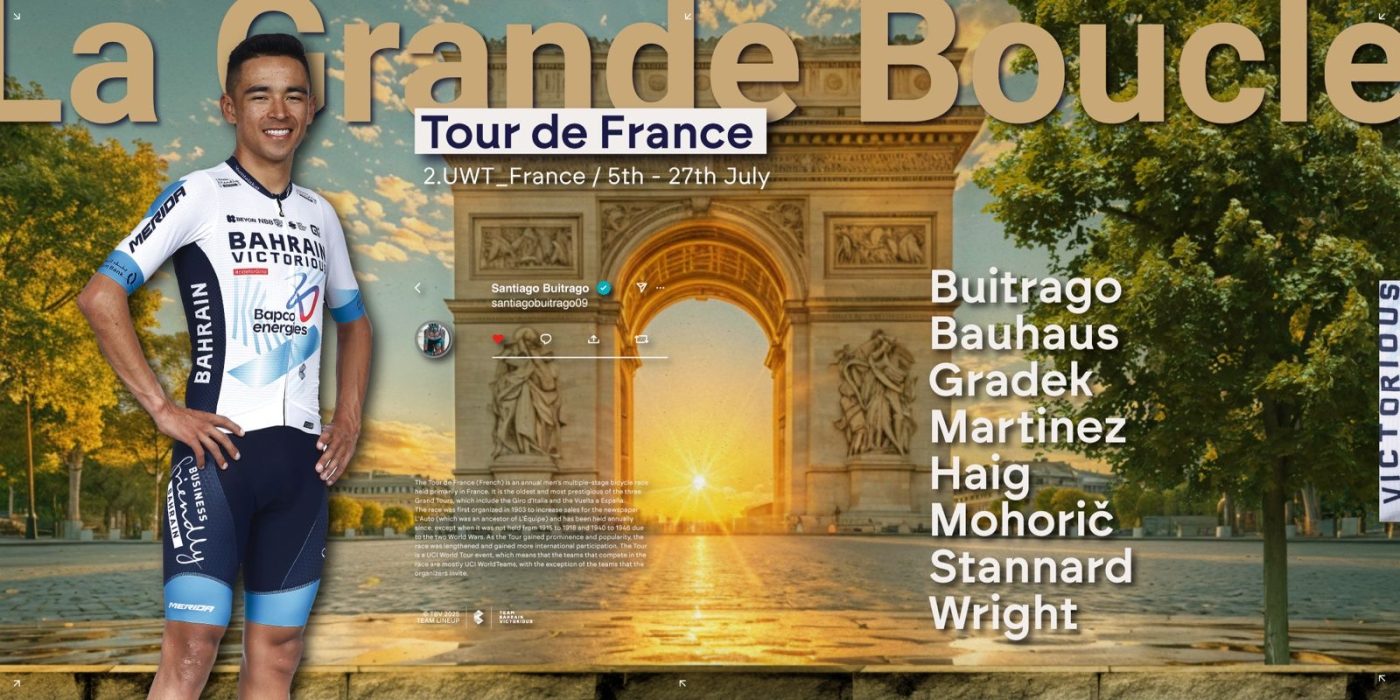In the cycling world, July means just one thing: The Tour de France. With the 2025 ‘Grand Boucle’ (Big Loop) just days away, anticipation and excitement is growing ahead of this year’s ‘Grand Depart’ next Saturday.
While it is not the oldest race on the calendar (Milano-Torino takes that honour, dating back to 1876, and Liège-Baston-Liège & Paris-Roubaix also had their began before Le Tour), it is without question the biggest, most prestigious, and best known. It remains, after all, the largest annual sporting event on the planet!
This will be the 112th Tour de France. 185 riders from 23 teams will start in Lille, hoping to complete a 3336.8km route to the Champs Élysées in Paris on Sunday 27th.
Following his impressive top ten overall last year, Team Bahrain Victorious will be led by Colombian Santiago Buitrago, with an experienced group of seven alongside him. The 25 year old is looking forward to once again testing himself against the best riders in the world:
“We start this 2025 Tour with lots of hopes, actually, to be honest, expectations. I’ve been training for this year’s Tour since the end in Nice last year. I wanted to prepare myself in the best way and be in the best condition.
Everything has been going well this season – we’ve worked hard on every aspect, and we’ve had some good results in the team, which has given me a lot of confidence for the three weeks ahead.”
The stages can be more or less categorised as seven flat, six hilly, and six in the mountains, plus two individual time trials on stage 5 (flat 32.9km) and stage 13 (10.9km steep uphill to Peyragudes).
For those faster, flatter finishes, Bahrain Victorious will have sprinter Phil Bauhaus, riding here for a third time. Having previously achieved four stage podiums, the German is seeking that elusive Tour victory. The majority of the opportunities for the quick men will be before the first rest day, which this year only comes after ten stages have been completed, due to ‘Bastille Day’ falling on a Monday.
Helping Phil to be in the right position to fight for that win will be Fred Wright and Robert Stannard. Fred has been close to a maiden Grand Tour success many times, with four stage podiums and ten top ten results. Despite being just 26, the former British champion arrives at the Tour for a fifth time. Conversely, Australian Stannard is the only member of the lineup making his Tour debut, and he and Wright will also be tasked with protecting Santi in the bunch.
Day one starts and finishes in the centre of the northeastern city of Lille and is a straightforward 184.9km circuit, while the following day, crosswinds and three climbs in the last 34km mean that puncheurs will fancy their chances. That pattern is replicated on stages three (Valenciennes – Dunkerque, 178km, flat) and four (Amiens Métropole – Rouen, 173km, hilly), before the first time trial which starts and ends in Caen.
The opening phase of this edition continues with two more hilly stages: Bayeux to Vire Normandie, 201km, and Saint-Malo to Guerlédan, 194km. Despite not being a bona fide ‘mountain stage’, Friday’s finish up the Mûr-de-Bretagne may well see the first forays of the GC contenders. Stages eight and nine are both flat, and both just over 170km, with finishes in Laval and Châteauroux.
July 14th is one of the most important public holidays in France, commemorating the storming of the Bastille in the 1789 French Revolution. Mirroring history, July 14th could be an important date in the 2025 Tour de France, as the bunch attempt to ‘storm’ eight little-known climbs of the Massif Central. It is only 163km long but includes 4,400 metres of climbing, and ends with a 3.5km climb to Le Mont-Dore Puy de Sancy, which averages 8%.
Nearly half of the 21 days could potentially influence the overall General Classification, and Sports Director Roman Kreuziger believes the chosen riders have all the attributes to take on the wide range of parcours:
“For this new Tour de France, I think we have a very nice, balanced team around Santiago with Phil as a clear sprinter, and then some jokers for the stages.
Compared to 2024, I think 2025 is a bit different. Elevation wise, very similar, but in the first nine days, almost no mountain finishes. Of course, there are many punchy finishes that could suit our riders, but also some windy stages and sprints, so it’s going to be a typical start to the Tour de France, with tension in the bunch.
Let’s hope that we come out of that part unscathed.”
Buitrago knows that the start holds many challenges:
“It’s a very different route from last year. We begin with 10 very complicated days in a row, where you can’t gain much but if you make a mistake you can say goodbye to the GC. Luckily we have a very complete team to be able to fight and have options.”
Buitrago’s main support in the mountains will come from a pair of riders at very different phases of their careers.
Jack Haig has five Tours under his belt already, and will be road captain on mountain days, while Lenny Martinez will be the first Frenchman to ride for Bahrain on the home roads of this most legendary of races. Martinez – who celebrates his birthday on stage seven – is here for a second time, and has had a phenomenal first half of his first season in our colours. Victories at Paris-Nice, the Tour of Romandie and most recently (and significantly), the Critérium du Dauphine, prove the 21 year old is going to be a crucial asset over the next three weeks.
Kreuziger believes that will be the case both on and off the bike:
“I think it’s nice to have a French rider in the team on a Grand tour for the first time. So we are looking forward to having Lenny there and seeing how he can go. He can also be the right added motivation for the guys in the team, because normally it always adds something extra.”
Buitrago agrees. The pair have raced together seven times already this season, including at Paris-Nice and the Dauphine.
“This year we have Lenny in the team. Without a doubt he is going help a lot. He’s a young rider with much much talent, and I believe that the Tour is a great opportunity for him to show the qualities that he has.”
‘Week’ two has The Pyrenees at its centre, with three mountain finishes, including that eye-catching mountain time trial on stage 13. Kreuziger expands:
“From stage 10, our tour starts a bit more with the climbers. In the second week we are in the Pyrenees with a spectacular uphill time trial, and 2 mythical finishes. Firstly. Hautacam, and later on Superbagnères.”
Stage 11 is a 154km loop around Toulouse which could suit the sprinters if they can cope with the five categorised climbs along the way. The following day is the first big mountain challenge, with the Col du Soulor before the summit finish at Hautacam, and after the ITT there is no let up. The 180.6km from Pau to Luchon-Sperbagnères also contains the Tourmalet, Aspin, and then Peyresourde, before the long climb to the line, which has a middle section that really bites. With those fabled climbs and 5000m of elevation gain, this is arguably the ‘Queen Stage’ this year. A hilly profile from Muret to Carcassonne leads into the second rest day.
On the rolling and flat stages, the team’s road captain will be triple Tour stage-winner, Matej Mohorič. Having also taken victories at both the Giro d’Italia and the Vuelta a España, as well as Milan-Sanremo in 2022, the Slovenian will also have some freedom to try to add another win to his already impressive palmares. Key support on the flat will also come from Pole Kamil Gradek; a ‘veteran’ at 34 years of age, a stalwart of the team, and a man who does a huge amount of largely unseen work for our leaders.
Week three will likely be pivotal in deciding the final standings. It begins with a start in Montpellier, and 134 pan flat kilometres, before one of the most famous climbs in cycling. Mont Ventoux provides the climax to a stage for the first time since 2013, and at 15.7km at 8.8% will present a demanding examination of who still has the legs to be involved in the final reckoning. Having completed ten Tours himself, Kreuziger understands well what the final week means:
“After the second rest day we move up to the coast, but from the coast quickly to the hills and to the famous Mon Ventoux. And from there on, we are in the Alps. It’s a very intense few days up there. We have reconned the stages, so we know what to expect.
It’s going to be a lot about strength, what’s left in the body, and definitely for the fans they are going to be spectacular stages to see on the road or on TV.”
Stage 17 should offer some respite, as the sprinters’ teams will be in action on an unchallenging 161km between Bollène and Vallence, before the GC battle recommences with a brutal 18th stage. There are three ‘Hors Categorie’ climbs on the last Thursday: the Col du Glandon (21.7km @ 5.1%), the Col de la Madeleine (19.2 km @ 7.9%) and concluding with the long road up to Courchevel and on to the Col de la Loze. That denouement is 26.2km at an average of 6.5%, and will be one of the longest finish climbs in the Tour’s 122 year history.
The closing high mountain trial comes on stage 9. Starting from Albertville for the ninth time, there are five categorised climbs over 129.9km, but it is the final one that will be conclusive: 19km at over 7% up to La Plagne.
The penultimate day’s racing will be in the Jura mountains. The profile is undulating enough to give hopes to a breakaway, and after the finish in Pontarlier there remains just the closing Sunday in Paris. But this year the race organisers have decided that stage 21 will not be the procession into the city centre that we have become used to. Kreuziger explains the changes:
“We cannot forget that the Tour is coming back to Paris after one year in Nice because of the Olympics, but not with the normal finish on Champs Élysées, with three laps there as in the past. The the new route includes a much longer lap which is the climb from the Olympic road race. I would say it’s not guaranteed that it will be a sprint, so it might be one extra opportunity and one extra effort for the guys. So if in the past after stage 20 we were saying, “you can take it easier and let’s see what happens on the last stage,” this year, again, it’s full focus till we cross the line in Paris close to the Arc de Triomphe.”
The 2025 Tour de France is a high-altitude test for the pure climbers, with five summit finishes, four major mountain ranges, and 43.9km against the clock. It includes many of the most celebrated climbs in our sport, and promises to be – as always – a roller-coaster month of sporting drama and excellence.
Kreuziger wants Bahrain Victorious to be active and opportunistic throughout: “I think our motto should be, ‘Let’s be racers and enjoy the race with ambition.’
Of course, with realistic goals, with our feet on the ground to protect Santi, to do a good GC, be fighters. I’m pretty sure there are going to be some chances on the road and we have to try to take them.”
As for Santi himself, his ambitions are to improve on his excellent Tour de France debut in 2024:
“I would like to improve on my top 10 position from last year. I’m hoping for the chance to fight for a stage, but the principal objective is to get move higher on GC. We have worked so hard as a team to try to get in the top 5, or even on the podium.”



